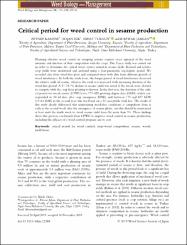| dc.contributor.author | Karnas, Zeynep | |
| dc.contributor.author | Işık, Doǧan | |
| dc.contributor.author | Tursun, Nihat | |
| dc.contributor.author | Jabran, Khawar | |
| dc.date.accessioned | 2021-06-11T16:46:32Z | |
| dc.date.available | 2021-06-11T16:46:32Z | |
| dc.date.issued | 2019 | en_US |
| dc.identifier.citation | Karnas, Z., Işık, D., Tursun, N., & Jabran, K. (2019). Critical period for weed control in sesame production. Weed Biology and Management, 19 (4), 121-128. | en_US |
| dc.identifier.issn | 1444-6162 | en_US |
| dc.identifier.issn | 1445-6664 | en_US |
| dc.identifier.uri | https://doi.org/10.1111/wbm.12188 | |
| dc.identifier.uri | https://hdl.handle.net/20.500.12899/221 | |
| dc.description.abstract | Planning effective weed control in cropping systems requires exact appraisal of the weed intensity and duration of their competition with the crops. This 2-year study was carried out in order to determine the critical weed control period in sesame fields. Related and relative crop yields were monitored and analyzed using a four-parametric log-logistic model. We recorded data from weed-free plots and compared these with data from different periods of weed interference. In both the study years, the longer period of weed interference decreased the relative yield of sesame, whereas the yield was increased with increasing duration of the weed-free period. A 51-78.7% decline in sesame yield was noted if the weeds were allowed to compete with the crop from planting to harvest. In the first year, the duration of the critical period for weed control (CPWC) was 177-820 growing degree days (GDD), which corresponded to 14-64 days after crop emergence (DAE), and between 170 and 837 GDD (13-64 DAE) in the second year; this was based on a 5% acceptable yield loss. The results of this study clearly elaborated that maintaining weed-free conditions is compulsory from as early as the second week after the emergence of sesame plants, and this should be maintained at least until the ninth week to avoid sesame yield losses by more than 5%. These findings show that growers can benefit from CPWC to improve weed control in sesame production, including the efficacy of a weed control program and its cost. | en_US |
| dc.language.iso | en | en_US |
| dc.publisher | Wiley-Blackwell | en_US |
| dc.relation.ispartof | Weed Biology and Management | en_US |
| dc.rights | info:eu-repo/semantics/closedAccess | en_US |
| dc.subject | Critical period for weed control | en_US |
| dc.subject | Crop–weed competition | en_US |
| dc.subject | Sesame | en_US |
| dc.subject | Weeds | en_US |
| dc.subject | Yield losses | en_US |
| dc.title | Critical period for weed control in sesame production | en_US |
| dc.type | Article | en_US |
| dc.authorid | 0000-0002-8765-0326 | en_US |
| dc.department | MTÖ Üniversitesi, Ziraat Fakültesi, Bitki Koruma Bölümü | en_US |
| dc.institutionauthor | Tursun, Nihat | |
| dc.identifier.doi | 10.1111/wbm.12188 | |
| dc.identifier.volume | 19 | en_US |
| dc.identifier.issue | 4 | en_US |
| dc.identifier.startpage | 121 | en_US |
| dc.identifier.endpage | 128 | en_US |
| dc.relation.publicationcategory | Makale - Uluslararası Hakemli Dergi - Kurum Öğretim Elemanı | en_US |
| dc.identifier.scopus | 2-s2.0-85077141972 | en_US |
| dc.identifier.scopusquality | Q3 | en_US |
| dc.identifier.wos | WOS:000537679800002 | en_US |
| dc.identifier.wosquality | Q3 | en_US |
| dc.indekslendigikaynak | Web of Science | en_US |
| dc.indekslendigikaynak | Scopus | en_US |


















